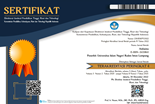Hubungan Empati Dengan Perilaku Konflik Dengan Orang Tua Dual-Career
Abstract
The aim of this study is to determine the relationship of empathy and conflict behavior in early adolescents who have dual-career parents. There were two instruments: The Basic Empathy Scale (BES) by Jolliffe and Farrington (2006 and Conflict Behavior Questionnaire (CBQ) by Robin & Foster (1989). A total respondents of this study were 252 adolescents (N male = 95; N female = 157) obtained online through self-selected polls. By the Spearman's Product Moment correlation analysis, the results showed that there was a significant negative between empathy and conflict behavior in early adolescents with dual-career parents (r = -0,277 p <0.05). The results also showed that there were significant differences in conflict behavior between ages 13 years to 16 years, where the age of 14 years was higher (M = 152.83) in experiencing conflict behavior compared to other ages. The implication of this research highlighted the importance of developing empathy in adolescents as an effort to minimize conflict with parents.
Keywords
Full Text:
PDFReferences
Allison, B.N. and Schultz, J.B. (2004). Parent-adolescent conflict in early adolescent. Adolescence, 39 (153): 101119.
Barker, R. L. (2003). The social work dictionary.Washington, DC: NASW Press
Barr, J. J., & Higgins-D’Alessandro, A. (2009). How adolescent empathy and prosocial behavior change in the context of school culture: A 2-year longitudinal study. Adolescence, 44, 751–772.
Branje, S. J. T., Laursen, B., & Collins, W. A. (2013). In A. L. Vangelisti (Ed.), Parentechild communication during adolescence (2nd ed., pp. 271e286). New York, NY: Routledge.
Christine, W, S., Oktorina, M & Mula, I. (2010). Pengaruh Konflik Pekerjaan dan Konflik Keluarga Terhadap Kinerja Dengan Konflik Pekerjaan Keluarga Sebagai Intervening Variabel (Studi Pada Dual Career Couple di Jabodetabek). Jurnal Manajemen dan Kewirausahaan 12(2), 121-132.
Damayanti, Wardyaningrum. 2013. Komunikasi Untuk Penyelesian Konflik Dalam Keluarga: Orientasi Percakapan Dan Orientasi Kepatuhan. Jurnal Al-Azhar Indonesia Seri Pranata Sosial
Del Barrio, V., Aluja, A., & García, L.F. (2004). Relationship between empathy and the Big Five personality traits in a sample of Spanish adolescents. Social Behavior and Personality, 32(7), 677-682. doi: 10.2224/sbp.2004.32.7.677
Eisenberg, N., Hofer, C., Losoya, S., Spinrad, T. L., & Liew, J. (2015). Parent – Adolescent Conflict as Sequences of Reciprocal Negative Emotion : Links with Conflict Resolution and Adolescents ’ Behavior Problems. Journal of Youth and Adolescence, 44(8), 1607–1622. https://doi.org/10.1007/s10964-014- 0209-5
Elloy, D, F & Smith, C, R. (2003). Pattern of Stress, Work-Family Conflict, Role Conflict, Role Ambiguity, And Overload Among Dual-Career And Single Career Couple: An Australian Study. Cross cultural managemnent 10(1), 55-65.
Fitri, S., & Masturah, A. (2019). Pengaruh Layanan Konseling Kelompok Dengan Teknik Problem Solving untuk Mengatasi Konflik antara Remaja yang Memiliki Insecure Attachment dengan Orang Tua. INSIGHT: Jurnal Bimbingan Konseling, 8(1), 92-112.
G¨uroglu, B., van den Bos,W.,& Crone, E. A. (2009). Neural correlates of social decision making and relationships. Annals of the New York Academy of Sciences, 1167, 197–206.
Henny Hairuddin, 2015, Berita-Berikut-Ini-Pemicu-Konflik-Antara-Remaja-Dan-Orang-Tua, (Http://Surabayapost.Net/. Diakses 20 Febuari 2016)
Hurlock, E.B. (1994). Psikologi Perkembangan Suatu Pendekatan Rentang Kehidupan. Jakarta: Erlangga
Hurlock, E.B. (2000). Perkembangan anak. Jakarta: Erlangga.
Jolliffe, D., & Farrington, D. P. (2006). Development and validation of the Basic Empathy Scale. Journal of Adolescence, 29(4), 589-611. doi: 10.1016/j.adolescence.2005.08.010
Jolliffe, D., & Farrington, D. P. (2004). Empathy and offending: A systematic review and meta-analysis. Aggression and Violent Behavior, 9(5), 441-476. doi: 10.1016/j.avb.2003.03.001
Khaleque, A., Kamal, M., & Anjuman, U. (2016). Cognitive and Contextual Factors Mediating the Relation Between Interparental Conflict and Adolescents ’ Psychological Maladjustment. Journal of Child and Family Studies, 25(2), 669–677. https://doi.org/10.1007/s10826-015- 0247-y
Kusmiyati. (2013) Berbagai Perilaku Kenakalan Remaja yang Mengkhawatirkan. Diakses dari https://www.liputan6.com/health/read/688614/berbagai-perilaku-kenakalan-remaja-yang-mengkhawatirkan
Laursen, B. (1995). Conflict and social interaction in adolescent relationships. Journal of Research on Adolescence, 5(1), 55e70.
Laursen, B., & Collins, W. (2009). Parent–child relationships during adolescence. In R. Lerner & L. Steinberg (Eds.), Handbook of adolescent psychology: Vol. 2. Contextual influences on adolescent development (3rd ed., pp. 3–42). New York: Wiley.
Marici, M. (2015). The Influence of Parent-Child Conflict Intensity and Frequency in Social-Cognitive Domains on the Psycho-Behavioural Consequences in Adolescents. The Scientific Annals of “Al. I. Cuza” University, New Series, Psychology-Pedagogy, 24.
Monks, F. J., Knoers, A. M., & Haditono, S. R. (2006). Psikologi Perkembangan . Yogyakarta: Gadjah Mada University Press.
Oberle, E., Schonert-Reichl, K.A., & Thomson, K.C. (2010). Understanding the link between social and emotional well-being and peer relations in early adolescence: Gender-specifi c predictors of peer acceptance. Journal of Youth and Adolescence, 39, 1330-1342. doi: 10.1007/s10964-009-9486-9
Ozmete, E. & Bayoglu, A.S. (2009). Parent-young adult conflict: A measurement of frequency and intensity of conflict issues. The Journal of International Social Research, 2, 8. Ankara University.
Papalia, E. D., Olds, W. S., & Feldman, D. R. (2009). Perkembangan Manusia. Buku 2, Edisi 10. Jakarta: Salemba Humanika
Pinquart, M., & Silbereisen, R. K. (2002). Changes in adolescents’ and mothers’ autonomy and connectedness in conflict discussions: An observation study. Journal of Adolescence, 25, 509–522.
Ratnawati, V. (2017). Kondisi Keluarga Dan Kenakalan Anak. Efektor, 4(2), 1-6.
Reivich, K., & Shatte, A. (2002).The Resilience factor: 7 Essential skills or overcoming life in evitable obstacles. New York: Broadway Books
Richardson, D. R., Hammock, G. S., Smith, S. M., Gardner, W., & Signo, M. (1994). Empathy as a cognitive inhibitor of interpersonal aggression. Aggressive Behavior, 20(4), 275e289. http://dx.doi.org/10.1002/1098-2337(1994)20:43.0.CO;2-4.
Robin, A. L., & Foster, S. L. (1989). Negotiating parent–adolescent conflict: A behavioral-family systems approach. New York, NY: Guilford Press.
Santrock, John W. (2002). Life-Span Development: Perkembangan Masa Hidup.(Edisi Kelima). Jakarta: Erlangga
Santrock, J. W. (2007). Remaja, Edisi 11. Erlangga.
Santrock, J. W. (2013). .Lifespan Development. Fourth edition. USA : The McGraw-Hill Companies.
Saraceno, C. (2007). Introduction to the special issue: Dual-career couples. Zeitschrift für Lazarus, R.S. (1993). Coping theory and Familienforschung, 19, 3
Smetana, J. G., Daddis, C., & Chuang, S. S. (2003). “Clean your room!” A longitudinal investigation of adolescenteparent conflict and conflict resolution in middle-class African American families. Journal of Adolescent Research, 18(6), 631e650.
Smetana, Judith G. (2011). Adolescents, Families, and Social Development How Teens Construct Their Worlds. UK. Wiley-Blackwell
Stuart, G. W. (2016). Prinsip dan Praktik Keperawatan Jiwa Stuart, edisi Indonesia pertama oleh Budi Anna Keliat dan Jesika Pasaribu. Singapore. Elsevier
Swanstroem, N.L.P & Weismann, M.S. (2005). Conflict, conflict prevention and conflict management and beyond: a conceptual exploration. Concept Paper, summer 2005. Central Asia-Caucasus Institute & Silk Road Studies Program. Johns Hopkins University. Washington. Uppsala University. Sweden.
Tucker, C. J., McHale, S. M., & Crouter, A. C. (2003). Conflict resolution: Links with adolescents’ family relationships and individual well-being. Journal of Family Issues, 24, 715–736.
Van Lissa, C. J., Hawk, S. T., Branje, S. J., Koot, H. M., Van Lier, P. A., & Meeus, W. H. (2015). Divergence between adolescent and parental perceptions of conflict in relationship to adolescent empathy development. Journal of youth and adolescence, 44(1), 48-61.
Van Lissa, C. J., Hawk, S. T., Branje, S., Koot, H. M., & Meeus, W. H. (2016). Common and unique associations of adolescents' affective and cognitive empathy development with conflict behavior towards parents. Journal of Adolescence, 47, 60-70.
DOI: http://dx.doi.org/10.24042/ajp.v3i2.13133
Refbacks
- There are currently no refbacks.
Copyright (c) 2021 ANFUSINA: Journal of Psychology













